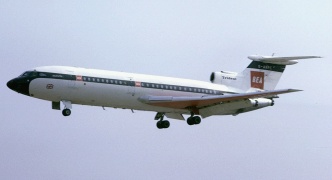
Given the political climate of the era, the nationally owned airlines practically dictated the specifications of the airliners produced by British companies in the 1950s and 60s. Due to a temporary downturn in air travel, BEA deemed the original DH121 design too large and demanded it be reduced in size. This resulted in the Trident 1C for with a lower capacity of just 96. This proved to be only temporary and BEA later regretted this decision. The original Trident design features a complex nose gear bay door arrangement, Krueger flaps and leading edge droops and the APU is mounted in a pod above the central engine. As the 1C was only sold to BEA, Hawker Siddeley realised an export derivative was needed and this model became the Trident 1E. The 1E and its derivatives were based on essentially the same airframe, but had a new leading edge slat arrangement, uprated engines, greater range and most importantly a higher capacity. The 1E sold in small numbers to British airlines BKS and Channel and to PIA, Kuwait, Iraqi, Cyprus Airways and Air Ceylon.
Trident 1C, Photo: Steve Williams






